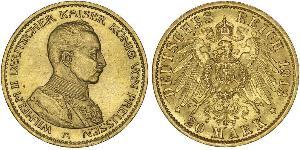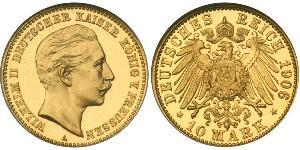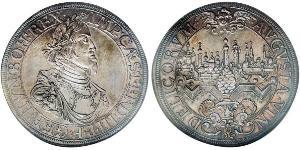1 Thaler Reino de Prusia (1701-1918) Plata Wilhelm I, German Empe ...
Metal:
Estado:
Año(s) de emisión:
1867
Referencia en catálogo:
1867, Reino de Prusia, Guillermo I "el Grande". Moneda Thaler de Plata. Año de acuñación: 1867 Referencia: KM-494. Denominación: Thaler (Vereinstaler)Peso: 18,49g Diámetro: 33mm Material: Plata
Anverso: Cabeza de Federico Guillermo I "el Grande" a derecha. Marca de ceca de Berlín (A) debajo. Leyenda: WILHELM KOENIG VON PREUSSEN Reverso: Corona sobre el águila prusiana con monograma (FR) en el pecho y cadena de órdenes, sosteniendo cetro y orbe. Leyenda: EIN VEREINSTHALER – XXX EIN PFUND FEIN 1867 Guillermo I, también conocido como Guillermo "el Grande" (William Frederick Louis, alemán: Wilhelm Friedrich Ludwig) (22 de marzo de 1797 – 9 de marzo de 1888) de la Casa de Hohenzollern era el Rey de Prusia (2 de enero de 1861 – 9 de marzo de 1888) y primer emperador alemán (18 de enero de 1871 – 9 de marzo de 1888). Bajo el liderazgo de Wilhelm y su primer ministro Otto von Bismarck, Prusia logró la unificación de Alemania y el establecimiento del Imperio Alemán.
El 2 de enero de 1861 murió Federico Guillermo y Guillermo ascendió al trono como Guillermo I de Prusia. Heredó un conflicto entre Federico Guillermo y el parlamento liberal. Se le consideraba una persona políticamente neutral ya que intervenía menos en política que su hermano. Sin embargo, William encontró una solución conservadora al conflicto: nombró a Otto von Bismarck para el cargo de Primer Ministro. Según la constitución prusiana, el Primer Ministro era responsable únicamente ante el rey, no ante el parlamento. A Bismarck le gustaba ver su relación laboral con Wilhelm como la de un vasallo de su superior feudal. No obstante, fue Bismarck quien dirigió efectivamente la política, tanto interior como exterior; en varias ocasiones obtuvo el consentimiento de Wilhelm amenazando con dimitir.
Tras la guerra franco-prusiana, Guillermo fue proclamado emperador de Alemania el 18 de enero de 1871 en el Palacio de Versalles. Bismarck eligió cuidadosamente el título de "Emperador alemán" después de debatirlo hasta (y después) el día de la proclamación. Guillermo aceptó este título a regañadientes porque hubiera preferido "Emperador de Alemania", lo cual, sin embargo, era inaceptable para los monarcas federados y también habría señalado un reclamo sobre tierras fuera de su reinado (Austria, Suiza, Luxemburgo, etc.). El título de "Emperador de los alemanes", propuesto en 1848, fue descartado porque se consideraba elegido "por la gracia de Dios", no por el pueblo como en una república democrática. Mediante esta ceremonia, la Confederación de Alemania del Norte (1867-1871) se transformó en el Imperio Alemán ("Kaiserreich", 1871-1918). Este Imperio era un estado federal; el emperador era jefe de estado y presidente (primus inter pares – primero entre iguales) de los monarcas federados (los reyes de Baviera, Wurtemberg, Sajonia, los grandes duques de Baden, Mecklemburgo, Hesse, así como otros principados, ducados y Senados de las ciudades libres de Hamburgo, Lübeck y Bremen). El 11 de mayo de 1878, Max Hödel fracasó en un intento de asesinato de Wilhelm en Berlín. El 2 de junio de 1878, el anarquista Karl Nobiling realizó un segundo intento, que hirió a Wilhelm antes de suicidarse. Estos intentos se convirtieron en el pretexto para la institución de la Ley Antisocialista, que fue introducida por el gobierno de Bismarck con el apoyo de una mayoría en el Reichstag el 18 de octubre de 1878, con el fin de luchar contra el movimiento socialista y obrero. Las leyes privaron al Partido Socialdemócrata de Alemania de su personalidad jurídica; prohibieron todas las organizaciones, las organizaciones obreras de masas y la prensa socialista y obrera, decretaron la confiscación de la literatura socialista y sometieron a los socialdemócratas a represalias. Las leyes se ampliaron cada 2 o 3 años. A pesar de esta política de represalias, el Partido Socialdemócrata aumentó su influencia entre las masas. Bajo la presión del movimiento obrero de masas, las leyes fueron derogadas el 1 de octubre de 1890. En sus memorias, Bismarck describe a Wilhelm como un caballero anticuado, cortés, infaliblemente educado y un auténtico oficial prusiano, cuyo buen sentido común se veía ocasionalmente socavado. por "influencias femeninas".
107
monedas en el grupo
Ver todas las monedas en el grupo
Ver todas las monedas en el grupo
(740 X 369 píxeles, tamaño de archivo: ~58K)
Publicado por: anonymous 2020-11-29
1865,Brandenburg-Preußen. Wilhelm I. 1861-1888. Taler 1865 A. Jaeger 96, Thun 270, AKS 99, Kahnt 388. Winzige Randfehler, vorzüglich - Stempelglanz.
(1737 X 851 píxeles, tamaño de archivo: ~380K)
Publicado por: anonymous 2021-05-05
1867, Kingdom of Prussia, Wilhelm I "the Great". Silver Thaler Coin. Cleaned XF! Mint Year: 1867 Reference: KM-494. Denomination: Thaler (Vereinstaler) Condition: Sharp cleaning (hairlines!), a few edge-hits, toned, light deposits, otherwise XF! Weight: 18.48gm Diameter: 33mm Mater ...
(740 X 368 píxeles, tamaño de archivo: ~62K)
Publicado por: anonymous 2020-11-25
1868,Brandenburg-Preußen. Wilhelm I. 1861-1888. Taler 1868 A. Jaeger 96, Thun 270, AKS 99. Winzige Kratzer, fast Stempelglanz.
(1537 X 750 píxeles, tamaño de archivo: ~263K)
Publicado por: anonymous 2019-07-11
1866, Kingdom of Prussia, Wilhelm I "the Great". Beautiful Silver Thaler Coin. Mint Year: 1866 Reference: KM-494. Denomination: Thaler (Vereinstaler) Condition: Minor greenish deposits on edge, uneven toning in reverse, light scratches in obverse, otherwise a nice AU-UNC! Weight: 18 ...
(1500 X 750 píxeles, tamaño de archivo: ~229K)
Publicado por: anonymous 2019-03-24
Brandenburg-Preußen. Wilhelm I. 1861-1888. Taler 1867 A. Jaeger 96, Thun 270, AKS 99. Vorzüglich
(1500 X 751 píxeles, tamaño de archivo: ~189K)
Publicado por: anonymous 2019-03-24
Brandenburg-Preußen. Wilhelm I. 1861-1888. Taler 1869 A. Jaeger 96, Thun 270, AKS 99, Kahnt 388. Fast Stempelglanz
Articles
|
Usted podría estar interesado en las siguientes monedas
2025-05-24
- Historical Coin Prices
1 Ducat Provincias Unidas de los Países Bajos (158 ...
Precios de moneda de fuentes públicas
Detalles
2025-05-24
- New coin is added to 2 Gulden null Plata
2 Gulden null Plata
grupo tiene 72 monedas / 71 precios
⇑
1848, Frankfurt (Free City). Silver 2 Gulden "Vicariat Election" Coin. AU-UNC! Struck on the election of Archduke John's as Vicar of the City! Mint Year: 1848 Mintage: 36,000 pcs. References ...
Usted podría estar interesado en …

-500-250-v1UKbzbimW4AAAFRTZdau0ye.jpg)
-300-150-V5DDyKwrw7UAAAF27cuESxIW.jpg)
-300-150-OCrrODoyUloAAAF5yG7o0jsk.jpg)
-300-150-fVgM7svH2XYAAAF29qiUxgFM.jpg)
-300-150-fLdPj8UH3h0AAAFrEAOz5tgf.jpg)
-300-150-vBfZGYbca0UAAAFpUpWZt64t.jpg)
-300-150-cSTZGYbcdfoAAAFpf2gZt7GY.jpg)














